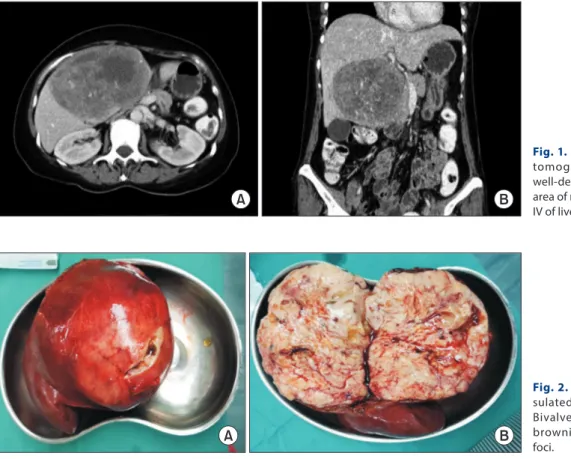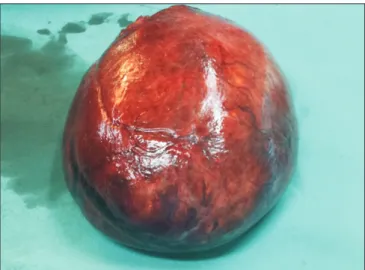Primary pleomorphic liver liposarcoma:
A case series and literature review
Chuah Jun Sen
1,2, Siaw Jia Yng
3, Soon Koon Choon
3, Fatin Izni Zamri
41
Department of General Surgery, Pusat Perubatan Universiti Kebangsaan Malaysia, Kuala Lumpur, Malaysia,
2
Department of General Surgery, Hospital Sultanah Aminah, Ministry of Health Malaysia, Johor Bahru, Malaysia,
3
Department of General Surgery, Sarawak General Hospital, Ministry of Health Malaysia, Kuching, Malaysia,
4
Department of Pathology, Sarawak General Hospital, Ministry of Health Malaysia, Kuching, Malaysia
Case Report
Primary hepatic liposarcoma is an extremely rare mesenchymal tumor that accounts for only 0.1% to 2% of primary malignant liver tumors. Due to its rarity, there is a lack of knowledge about its clinical course, management, and prognosis. Only 15 cases of primary liposarcoma of the liver have been reported since 1973. Among these 15 cases, only two involved primary liver liposarcoma with a pleomorphic subtype. Here we report the third and fourth cases of primary pleomorphic liver liposarcoma. A 57-year-old female pre- sented with abdominal discomfort and progressive abdominal distension for two weeks. Computed tomography (CT) of her abdomen revealed a large well-defined solid nodule mass with an area of necrosis and hemorrhage occupying segment IV-B of the liver. Wide local excision was performed. She had an uneventful recovery and remained well at six months post-treatment. A 65-year-old male presented with an abdominal mass for two-month. CT demonstrated a mass in the left lobe of the liver with mixed soft tissues and fat attenuation. He underwent wide local excision. He was discharged on day three postoperatively. Histological analysis for both cases revealed liposarcoma of the liver with a pleomorphic subtype.
Key Words: Liver neoplasm; Liposarcoma
INTRODUCTION
Primary hepatic liposarcoma is extremely rare, accounting for only 0.1% to 2% of primary malignant liver tumors [1]. Li- posarcoma originating from the mesenchymal tissue is typical- ly found in the shoulder, extremities, and the retroperitoneum space [2]. Primary hepatic liposarcoma can be divided into five subtypes (myxoid, well-differentiated, dedifferentiated, pleo- morphic, and myxoid pleomorphic), with pleomorphic lipo- sarcoma being the rarest subtype [3]. The clinical presentation of primary hepatic liposarcoma is highly variable. Early diag-
nosis of liver liposarcoma is challenging because most patients remain asymptomatic until mass effects such as abdominal pain, abdominal distention, or obstructive jaundice symp- toms emerge. Some might experience fever, nausea, vomiting, and weight loss. Physical examination might reveal a palpable abdominal mass. A computed tomography (CT) scan may provide certain typical characteristics of liver liposarcoma, making it the best tool to evaluate the resectability of liver sar- coma. Complete resection with clear margin is likely a curative therapy. To the best of our knowledge, only two cases of pri- mary pleomorphic liver liposarcoma have been reported in the literature. Here, we present two more cases of primary pleo- morphic liver liposarcoma with successful curative resection at our center. Written informed consent was obtained from both patients for publication of this case report and accompanying images.
CASES
Case 1
A 57-year-old female presented with abdominal discomfort and progressive abdominal distension for two weeks. She de-
Received: February 22, 2021, Revised: March 8, 2021, Accepted: March 10, 2021
Corresponding author: Chuah Jun Sen
Department of General Surgery, Hospital Sultanah Aminah, Ministry of Health Malaysia, Jalan Persiaran Abu Bakar Sultan, Johor Bahru 80100, Johor, Malaysia Tel: +60-16-7727965, Fax: +60-7-2231666, E-mail: vincentchuahjs@gmail.com ORCID: https://orcid.org/0000-0002-1439-8027
Copyright Ⓒ The Korean Association of Hepato-Biliary-Pancreatic Surgery
This is an Open Access article distributed under the terms of the Creative Commons Attri- bution Non-Commercial License (http://creativecommons.org/licenses/by-nc/4.0) which permits unrestricted non-commercial use, distribution, and reproduction in any medium, provided the original work is properly cited.

